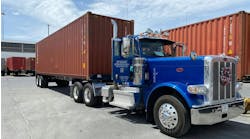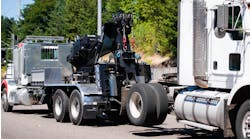People packed Fleet Owner’s virtual conference room recently to hear two experts from the National Transportation Institute -- Gordon Klemp, CEO and Leah Shaver, vice president, sales and marketing—talk about driver recruiting and retention in a webinar called, Helping New Drivers Succeed and Stay. The free webinar was presented by Fleet Owner and sponsored by Verizon Networkfleet.
From the very beginning, it was clear that this was not going to be a “big-picture, broad-brush” program, but rather a “take notes as fast as you can” event. And now it is also available for viewing on-demand, free of charge.
Klemp got things rolling with a sometimes surprising look at the driver shortage today and its root causes. Today’s economy is far short of “robust,” he observed. If it suddenly jumped to five percent growth, for example, it would make it even harder to find drivers than it is now.
From 2007 to 2011, the industry literally recruited no new drivers, he added, none at all. In fact, fleets let drivers go and many others retired early. The growth in intermodal sopped up other good driver candidates.
Watch the free webinar: Helping New Drivers Succeed and Stay
However, perhaps the most shocking reason for the declining driver pool, according to Klemp, is what he called “the underground economy,” a phenomena studied by Dr. Edgar L. Feige at the University of Wisconsin. The so-called underground economy used to be comprised largely of people who engaged in a variety of illegal activities for profit, he noted. Today they have been joined by people who have abandoned jobs such as trucking and entered the welfare ranks instead, supplementing their various support checks with “off the books” part time jobs for cash, such as snow-blowing or other day labor.
“Lots of former drivers get by this way,” Klemp said.
To make the driver problem worse still, the industry has an “aging and inverted workforce” he added. You would want younger people in highly physical jobs like trucking, but that is not the case. People aged 21-24 comprise only 1.3% of the driver workforce; those 25-29 make up 6.2% of drivers; those 30-34 make up 9.7% ; while drivers aged 35-44 comprise 31.8% of drivers.
“We don’t retire drivers as much as we wear them out,” Klemp observed. “They leave trucking for physical reasons.”
Driver pay has not kept pace with inflation, either, even though the industry now has the highest per-mile pay rate ever, Klemp reported. In the last 20 years, there has been about a 40% growth in driver pay, but drivers have actually lost money due to inflation. Flatbed drivers are doing the best, pay-wise, he added, and they are expected to continue to do well.
Colleague, Leah Shaver, took the podium after Gordon Klemp to outline some very concrete things fleets can do to help improve their own driver retention numbers. Drivers are in high demand and there is high turnover, she said. Your drivers will be pursued all the time by other carriers, that it just the way it is. As a result, drivers are very much about “what have you done for me today?”
For starters, she encouraged fleets to provide drivers with cell phones. They are relatively inexpensive but they mean a lot to drivers, she observed because there is “not a lot of support out there” from family and friends or from society as a whole because of the poor image of drivers in general. Cell phones allow them to have video chats with family and friends.
Shaver also strongly recommended that fleets use an “applicant tracking system” which scores applicants by factors such as how often they change jobs and how often they apply for new jobs. They can also help fleets determine how well recruiting tools such as job boards and employment agencies are really working. You should keep a balance of drivers in your fleet, she added. Mix your hiring to include students and old hands, job-hoppers and referrals.
She also urged fleets to create a new driver mentoring program. “Assign a neutral party to help new drivers transition [into your fleet],” she said. Mentoring works best if everybody is involved in mentoring, but if that is not practical, do your best to pair an existing employee who is positive and communicates well with new drivers.
It is also tough to over-estimate the importance of the dispatcher role in driver retention, according to Shaver. Put your new drivers with a dispatcher who is fast and technologically savvy, she said, and keep each dispatcher’s fleet size manageable. You need a strong match between planners and dispatchers, too.
Spend more money on developing fleet drivers not on hiring new drivers, Shaver encouraged. And don’t give up too quickly on drivers who need extra help and retraining.
Drivers want miles, money, home time and respect, she summarized. Retaining drivers is all about managing perceptions.



